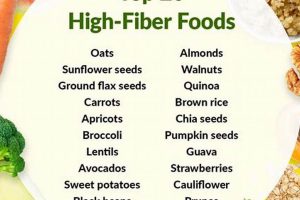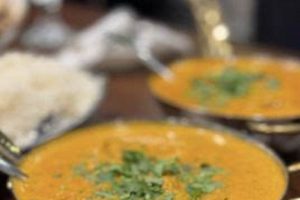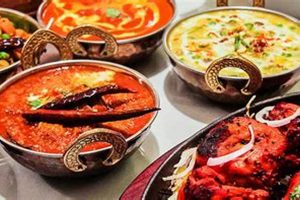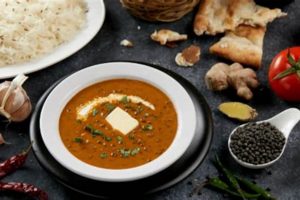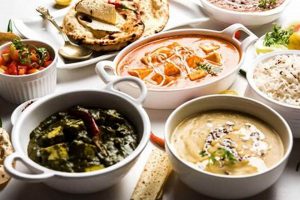Dietary choices play a crucial role in managing blood sugar levels. The culinary traditions of the Indian subcontinent offer a diverse range of options that can be adapted to support glycemic control. Understanding the carbohydrate content, glycemic index, and preparation methods of various dishes is essential when considering nutritional planning for individuals with diabetes.
Careful meal planning can significantly contribute to better health outcomes. Many traditional staples are rich in fiber, complex carbohydrates, and beneficial fats, which can promote satiety and regulate glucose absorption. Furthermore, the historical and cultural significance of spices in this cuisine provides antioxidant and anti-inflammatory benefits that may positively impact overall well-being.
The following sections will delve into specific food groups, preparation techniques, and mealtime strategies relevant to maintaining stable blood sugar levels while enjoying the flavors of the region. Emphasis will be placed on practical guidance for making informed decisions about ingredient selection, portion sizes, and cooking methods.
Dietary Guidance for Managing Blood Sugar
This section provides practical advice on incorporating the cuisine of the Indian subcontinent into a dietary plan suitable for individuals managing diabetes. The guidelines prioritize balanced nutrition, controlled portion sizes, and mindful food choices.
Tip 1: Prioritize Whole Grains. Opt for whole wheat flour (atta) over refined flour (maida) for rotis and other bread. Whole grains have a lower glycemic index, resulting in a slower release of glucose into the bloodstream.
Tip 2: Control Portion Sizes. Be mindful of the amount of rice consumed. A small bowl (approximately 1 cup cooked) is a more appropriate serving size than a large plateful. Consider brown rice or other whole-grain alternatives for added fiber.
Tip 3: Emphasize Lentils and Legumes. Dals (lentil soups) and legumes (beans, chickpeas) are excellent sources of protein and fiber, which help regulate blood sugar levels. Include a serving of dal in most meals.
Tip 4: Include Plenty of Vegetables. Incorporate a variety of non-starchy vegetables into meals. Leafy greens (spinach, kale), gourds (bitter gourd, bottle gourd), and cruciferous vegetables (cauliflower, broccoli) are particularly beneficial.
Tip 5: Moderate Fat Intake. Use healthy cooking oils in moderation, such as olive oil, mustard oil, or rice bran oil. Avoid excessive use of ghee (clarified butter) and saturated fats.
Tip 6: Limit Sugary Foods and Beverages. Reduce or eliminate consumption of sweets, desserts, and sugary drinks like sweetened lassi or fruit juices. Choose naturally sweetened options or use sugar substitutes sparingly.
Tip 7: Monitor Blood Sugar Levels Regularly. Consistent blood sugar monitoring is essential for understanding how different foods affect individual glucose levels. Work with a healthcare professional to establish target ranges and adjust the dietary plan as needed.
Adhering to these recommendations can contribute to improved glycemic control, sustained energy levels, and overall well-being. These strategies emphasize mindful eating, balanced nutrition, and personalized dietary choices.
The concluding sections will offer insights on customizing dietary plans and seeking professional guidance for comprehensive diabetes management.
1. Glycemic Index and Dietary Choices
The glycemic index (GI) serves as a critical tool for individuals managing diabetes, particularly when incorporating elements of regional cuisine. The GI ranks carbohydrate-containing foods based on their potential to raise blood glucose levels. Foods with a high GI are rapidly digested and absorbed, leading to a sharp increase in blood sugar, while low-GI foods are digested more slowly, resulting in a gradual and more manageable rise.
In the context of the subcontinent’s cuisine, understanding the GI of common staples is essential. White rice, a prevalent carbohydrate source, possesses a relatively high GI. Replacing it with brown rice, quinoa, or millets, which have lower GI values, can contribute to improved glycemic control. Similarly, the type of flour used in roti (flatbread) significantly impacts the GI. Whole wheat flour is a better alternative to refined flour due to its higher fiber content and lower GI. The GI of a composite dish is influenced by all its ingredients. For example, a vegetable curry with lentils is likely to have a lower GI than a potato-based curry.
Selecting low-GI foods over high-GI options is a fundamental strategy for maintaining stable blood sugar levels. By carefully considering the GI of various dishes and ingredients, individuals with diabetes can enjoy the diverse flavors of the regions cuisine while effectively managing their condition. The practical implication of this understanding is enhanced meal planning and informed food choices, which are vital for overall diabetes management.
2. Portion Control
Effective management of diabetes through dietary adjustments necessitates strict attention to portion control. The culinary traditions of the Indian subcontinent, while rich in flavor and nutritional diversity, often involve dishes that are calorie-dense and carbohydrate-rich. Without careful modulation of serving sizes, even healthy ingredients can contribute to elevated blood glucose levels. For example, a generous serving of dal (lentil soup), despite its high fiber content, can significantly increase carbohydrate intake, thereby impacting glycemic control. Similarly, overconsumption of brown rice, even though it possesses a lower glycemic index than white rice, can lead to similar outcomes. Therefore, portion control is a fundamental mechanism through which the cuisine is rendered suitable for individuals with diabetes.
The practical application of portion control involves several strategies. Visual cues can be helpful; utilizing smaller plates and bowls can naturally limit the amount of food consumed. Measuring out specific quantities of staple foods, such as rice or roti, ensures consistency and prevents overeating. Paying close attention to satiety cues is also crucial; stopping when comfortably full, rather than eating until completely satiated, aids in preventing excessive calorie and carbohydrate intake. Furthermore, distributing meals evenly throughout the day helps maintain stable blood sugar levels and prevents large fluctuations that can result from consuming oversized portions at any one sitting. Careful consideration of the composition of meals helps ensure an adequate intake of nutrients without overdoing any single food group.
In summary, portion control is an indispensable component of managing diabetes within the framework of the cuisine of the Indian subcontinent. It is a critical factor in mitigating the potential for elevated blood sugar levels associated with carbohydrate-rich dishes. The challenge lies in balancing the enjoyment of flavorful food with the need for strict dietary regulation. Consistent adherence to portion control strategies, combined with regular blood glucose monitoring and consultation with healthcare professionals, can contribute to effective long-term diabetes management.
3. Fiber Content
Dietary fiber plays a significant role in managing blood sugar levels, making it a critical consideration within the framework of diabetic dietary planning, particularly concerning the culinary traditions of the Indian subcontinent. The presence and type of fiber in foods commonly consumed impact glucose absorption and overall metabolic health.
- Slowing Glucose Absorption
Fiber, especially soluble fiber, forms a gel-like substance in the digestive tract. This process slows the absorption of glucose into the bloodstream, preventing sharp spikes in blood sugar levels that are detrimental to individuals with diabetes. Foods rich in soluble fiber, such as lentils (dals) and certain vegetables, can effectively moderate postprandial glucose excursions.
- Promoting Satiety and Weight Management
High-fiber foods contribute to increased satiety, the feeling of fullness, which can aid in weight management. Obesity is a significant risk factor for type 2 diabetes, and maintaining a healthy weight is vital for disease prevention and control. Incorporating fiber-rich dishes, such as vegetable-heavy curries and whole-grain rotis, into the diet promotes satiety, potentially reducing overall calorie intake.
- Improving Insulin Sensitivity
Research suggests that a high-fiber diet can improve insulin sensitivity, allowing the body to utilize insulin more effectively. This improvement can reduce the need for medication and improve overall metabolic function. Foods like oats and barley, though not traditionally central to the cuisine of the subcontinent, can be integrated to enhance fiber intake and potentially boost insulin sensitivity.
- Sources of Fiber in Regional Cuisine
The cuisine offers various sources of dietary fiber, including legumes, vegetables, whole grains, and certain fruits. Dals, chickpeas (chana), and kidney beans (rajma) are excellent sources. Non-starchy vegetables, such as spinach (palak), fenugreek leaves (methi), and various gourds, provide fiber alongside essential vitamins and minerals. Replacing refined grains with whole grains like whole wheat flour (atta) and brown rice significantly increases fiber intake.
By strategically incorporating fiber-rich ingredients and dishes into the diet, individuals with diabetes can leverage the benefits of fiber content to manage blood sugar levels, promote satiety, and improve insulin sensitivity. The diversity of the cuisine allows for creating palatable and sustainable dietary plans that support long-term health.
4. Spice Benefits
The incorporation of spices constitutes a significant facet of cuisine, particularly relevant in the context of dietary management for individuals with diabetes. These ingredients, beyond their culinary role, contribute bioactive compounds that may exert beneficial effects on glucose metabolism, insulin sensitivity, and overall health. The specific mechanisms through which spices influence diabetes management warrant detailed consideration.
Certain spices, such as turmeric (containing curcumin), cinnamon, fenugreek, and ginger, have demonstrated potential in modulating blood glucose levels. Curcumin possesses anti-inflammatory and antioxidant properties, which may improve insulin sensitivity and reduce the risk of diabetic complications. Cinnamon may enhance insulin action, facilitating glucose uptake by cells. Fenugreek seeds contain soluble fiber, which slows down glucose absorption and reduces postprandial hyperglycemia. Ginger has shown potential in improving insulin sensitivity and reducing oxidative stress. These are not cures, but they serve as adjuncts to conventional diabetes treatments and lifestyle modifications.
The mindful inclusion of spices in meal planning represents a practical strategy for enhancing the nutritional value of the cuisine and potentially mitigating some of the metabolic challenges associated with diabetes. While spices offer potential benefits, they must be viewed as complementary to, not replacements for, prescribed medications and lifestyle recommendations from healthcare professionals. Further research is warranted to fully elucidate the mechanisms and optimal dosages of various spices in the context of diabetes management.
5. Preparation Methods
Dietary choices significantly impact the management of diabetes, and within the context of the regional cuisine, preparation techniques are of paramount importance. How dishes are cooked and what ingredients are emphasized during preparation can either mitigate or exacerbate the glycemic impact of the food.
- The Impact of Frying
Deep-frying, a common practice in some regional dishes, introduces excessive amounts of saturated and trans fats. These fats can impair insulin sensitivity and contribute to weight gain, both detrimental to diabetes management. Avoiding fried items like samosas, pakoras, and certain sweets is advisable. Baking, grilling, steaming, or shallow-frying with minimal healthy oils represent healthier alternatives.
- Controlling Carbohydrate Sources
The preparation of carbohydrate-rich dishes requires careful consideration. For instance, when preparing rice, opting for brown rice over white rice and using methods that minimize starch content (such as rinsing the rice before cooking) can reduce the glycemic load. In dishes involving lentils and legumes, avoiding excessive use of ghee or creamy sauces helps maintain a balanced nutritional profile.
- Vegetable Handling
The manner in which vegetables are prepared can influence their nutrient retention and glycemic impact. Overcooking vegetables can diminish their vitamin and mineral content. Preparing vegetables in a way that preserves their fiber content is beneficial for glycemic control. Steaming or stir-frying vegetables lightly, rather than boiling them for extended periods, helps retain their nutritional value and fiber.
- Spice Utilization and Tempering
While spices offer potential benefits, the method of their incorporation is relevant. Tempering spices in oil (tadka) is a common technique. Using excessive amounts of oil during tempering can negate some of the benefits of the spices. Employing minimal oil or dry-roasting spices before adding them to dishes represents a healthier approach.
The preparation methods employed can significantly alter the nutritional profile and glycemic impact of regional dishes. By consciously adopting healthier cooking techniques and focusing on ingredient selection, individuals with diabetes can enjoy the diverse flavors of the cuisine while effectively managing their condition. Prioritizing baking, grilling, steaming, and mindful use of spices and oils enables a balanced and sustainable approach to dietary management.
6. Carbohydrate Sources
The selection of carbohydrate sources is a critical determinant in managing diabetes, particularly within the context of cuisine from the Indian subcontinent. The type, quantity, and preparation of these sources exert a significant influence on blood glucose levels and overall metabolic control. The following details the connection between specific carbohydrate sources and dietary management.
- Rice Varieties and Glycemic Impact
Rice constitutes a dietary staple in many regions. However, the glycemic index (GI) varies significantly among different types of rice. White rice, a commonly consumed variety, has a high GI, leading to rapid increases in blood glucose. Brown rice, basmati rice, and parboiled rice possess lower GI values due to higher fiber content and different starch compositions. Substituting high-GI rice with lower-GI alternatives represents a practical strategy for mitigating postprandial hyperglycemia.
- Wheat and Flour Composition
Wheat, in the form of roti (flatbread) and other preparations, is another prevalent carbohydrate source. Refined wheat flour (maida) has a higher GI compared to whole wheat flour (atta). The fiber content in whole wheat flour slows down glucose absorption. Incorporating whole grains like jowar, bajra, and ragi into roti preparations further enhances fiber intake and reduces the glycemic load. Selecting appropriate flour types is essential for maintaining stable blood glucose levels.
- Lentils and Legumes as Complex Carbohydrates
Lentils (dals) and legumes (beans, chickpeas) are integral components of the cuisine. These foods provide complex carbohydrates, protein, and fiber. The high fiber content contributes to a slower release of glucose into the bloodstream, making lentils and legumes beneficial for individuals managing diabetes. The preparation methods, such as avoiding excessive use of fats and creamy sauces, further enhance their health benefits.
- Root Vegetables and Starch Content
Root vegetables like potatoes, sweet potatoes, and yams are frequently used in the regional cuisine. These vegetables contain starch, which is a form of carbohydrate. The glycemic index of root vegetables varies depending on the type and preparation method. Boiling potatoes, for example, can increase their GI. Consuming root vegetables in moderation and combining them with fiber-rich foods can help manage their impact on blood glucose levels.
The strategic selection and preparation of carbohydrate sources are crucial for effective diabetes management within the framework of the subcontinent’s cuisine. Prioritizing whole grains, lentils, legumes, and lower-GI rice varieties, while moderating the intake of refined grains and high-GI root vegetables, enables individuals to enjoy the diverse flavors of the region while maintaining glycemic control. Careful attention to portion sizes and cooking methods further contributes to a balanced and sustainable dietary approach.
Frequently Asked Questions
This section addresses common inquiries regarding dietary management for individuals with diabetes, specifically concerning culinary practices from the Indian subcontinent. The answers provided aim to offer clarity and practical guidance based on current nutritional understanding.
Question 1: Are all dishes from the region unsuitable for individuals with diabetes?
No, a blanket generalization is inaccurate. Many traditional dishes can be adapted to align with dietary guidelines for diabetes management. Focusing on portion control, ingredient selection (prioritizing whole grains, legumes, and vegetables), and healthier cooking methods is crucial.
Question 2: Can rice be included in a diabetic diet?
Yes, but careful consideration is necessary. Opting for brown rice or basmati rice over white rice is advisable due to their lower glycemic index. Portion size should be controlled, and the rice should be combined with fiber-rich foods like lentils and vegetables to mitigate its impact on blood glucose levels.
Question 3: Are lentils and legumes beneficial for individuals with diabetes?
Yes, lentils (dals) and legumes (beans, chickpeas) are generally beneficial. They are rich in complex carbohydrates, protein, and fiber, which contribute to a slower release of glucose into the bloodstream. However, preparation methods that involve excessive use of fats should be avoided.
Question 4: What role do spices play in diabetes management?
Certain spices, such as turmeric, cinnamon, fenugreek, and ginger, have demonstrated potential in modulating blood glucose levels and improving insulin sensitivity. However, these spices should be viewed as adjuncts to, not replacements for, conventional diabetes treatments and lifestyle modifications.
Question 5: How can the glycemic index (GI) be utilized in meal planning?
The glycemic index (GI) ranks carbohydrate-containing foods based on their potential to raise blood glucose levels. Selecting low-GI foods over high-GI options is a fundamental strategy for maintaining stable blood sugar levels. Awareness of the GI values of various dishes and ingredients enables informed food choices.
Question 6: What are some healthier cooking methods for regional dishes?
Opting for baking, grilling, steaming, or shallow-frying with minimal healthy oils (such as olive oil or rice bran oil) represents healthier alternatives to deep-frying. Avoiding excessive use of ghee (clarified butter) and creamy sauces is also recommended.
Effective management of diabetes through dietary adjustments requires a nuanced understanding of ingredients, preparation methods, and portion control. Consulting with a registered dietitian or healthcare professional is essential for developing a personalized meal plan that aligns with individual needs and preferences.
The following sections will provide a summary of key recommendations and emphasize the importance of seeking professional guidance for comprehensive diabetes care.
Conclusion
This exploration of Indian food for diabetes reveals the critical role of dietary modifications in managing the condition. The analysis emphasizes the importance of informed choices regarding carbohydrate sources, preparation methods, portion control, and the strategic inclusion of spices. The potential benefits of fiber-rich ingredients and mindful cooking techniques are paramount in maintaining stable blood glucose levels.
The information presented underscores the necessity of seeking personalized guidance from healthcare professionals, including registered dietitians, to develop tailored dietary plans. Consistent blood glucose monitoring, coupled with professional support, enables individuals to navigate the culinary landscape of the Indian subcontinent effectively, fostering both well-being and optimized health outcomes. Adherence to established medical advice is crucial in achieving sustainable diabetes management.


